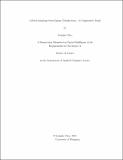Cubical homology-based Image Classification - A Comparative Study
Metadata
Show full item recordAuthor
Choe, Seungho
Date
2021-12-23Citation
Choe, Seungho. Cubical homology-based Image Classification - A Comparative Study; A Dissertation Submitted in Partial Fulfillment of the Requirements for the Degree of Master of Science in the Department of Applied Computer Science [University of Winnipeg]. Winnipeg, Manitoba, Canada: University of Winnipeg, 2021. DOI: 10.36939/ir.202112231202.
Abstract
Persistent homology is a powerful tool in topological data analysis (TDA) to compute, study and encode efficiently multi-scale topological features and is being increasingly used in digital image classification. The topological features represent number of connected components, cycles, and voids that describe the shape of data. Persistent homology extracts the birth and death of these topological features through a filtration process. The lifespan of these features can represented using persistent diagrams (topological signatures). Cubical homology is a more efficient method for extracting topological features from a 2D image and uses a collection of cubes to compute the homology, which fits the digital image structure of grids. In this research, we propose a cubical homology-based algorithm for extracting topological features from 2D images to generate their topological signatures. Additionally, we propose a score, which measures the significance of each of the sub-simplices in terms of persistence. Also, gray level co-occurrence matrix (GLCM) and contrast limited adapting histogram equalization (CLAHE) are used as a supplementary method for extracting features. Machine learning techniques are then employed to classify images using the topological signatures. Among the eight tested algorithms with six published image datasets with varying pixel sizes, classes, and distributions, our experiments demonstrate that cubical homology-based machine learning with deep residual network (ResNet 1D) and Light Gradient Boosting Machine (lightGBM) shows promise with the extracted topological features.

